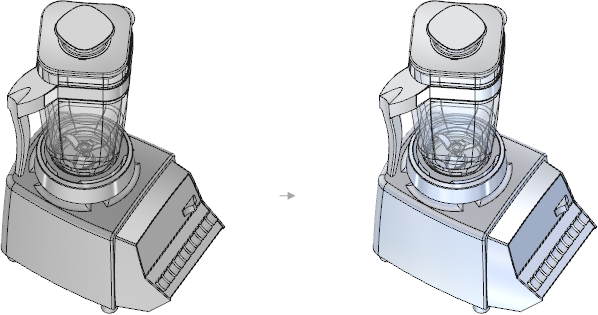The Rendering Style tool, in the Style group of the Display tab, allows you to change how solid faces are rendered. You can choose between a a shiny, light reflective finish (Metallic), a matte finish (Plastic), a sketched finish (Brushed), or a hatch line finish (Hatched). Assigning different rendering styles to a model helps you to better visualize parts, assemblies, or components as you develop your design.
In the images below, all four rendering styles are used: the top of the pitcher is set to plastic. The handle and pitcher are brushed. The blade base is hatched, and the base of the pitcher is set to metallic:

In the image set below, Regular display mode is shown on the left and Quick Rendering mode is shown on the right. Regular mode uses a single light source, while quick rendering mode uses multiple lights and reflects a background of sky and clouds on surfaces to give them depth and interest:

To change the rendering style of a solid or surface
-
Select the solid or surface.
-
Click
 Rendering Style in the Style group on the Display tab.
Rendering Style in the Style group on the Display tab.This icon changes to reflect the current setting, but always appears as a shaded sphere.
-
Select Hatched, Brushed, Metallic or Plastic to apply that surface style to the selected solid or surface.
To view objects in quick rendering mode
Press Ctrl + Shift + R to toggle quick rendering mode on or off.
Working with Keyshot rendering
After installing Keyshot™v2.2 v3.0, each DesignSpark Mechanical startup automatically retrieves installed Keyshot materials and preview images to provide you with the most recent rendering materials available.
Rendering with Keyshot can now be performed on lightweight assembly components. Lightweight components are a graphics-only representation of a design; only the component’s graphical information is loaded. Rendering designs with lightweight components reduces CPU memory and file size, which enhances DesignSpark Mechanical speed and performance.
Rendering with Keyshot can now be performed on mesh objects. Some very large objects can only be loaded as mesh objects when there is insufficient RAM. Rendering mesh objects reduces CPU memory and file size, which enhances DesignSpark Mechanical speed and performance.






